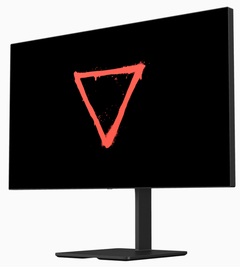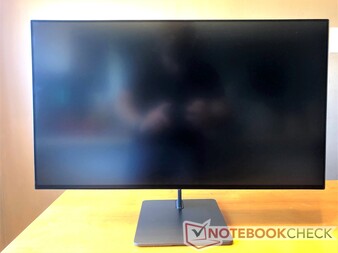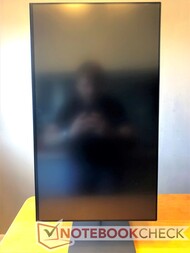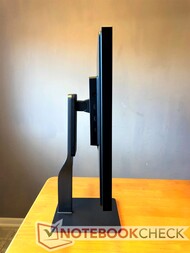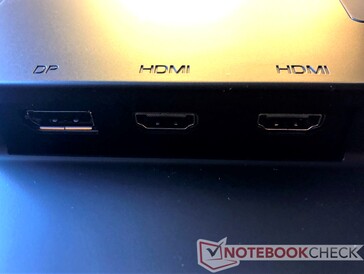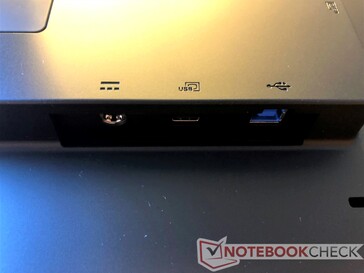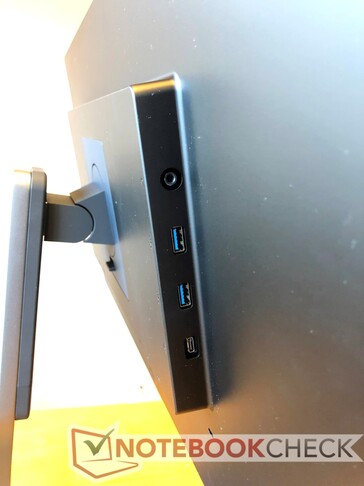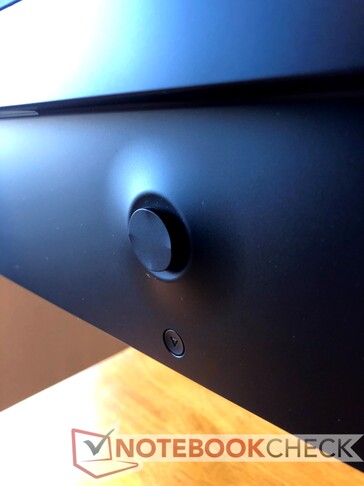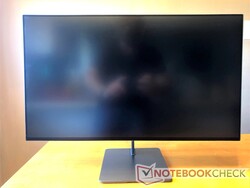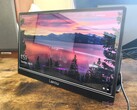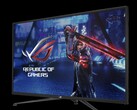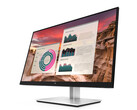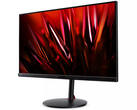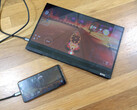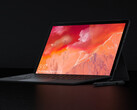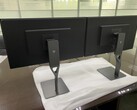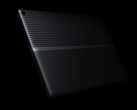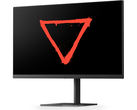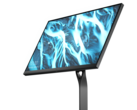Introduction
Eve's Spectrum gaming monitor has been on many people's radar since its unveiling in January 2020. There's a good reason for that: While the monitor promises high specs at a competitive price, Eve has a messy history with the tech community. The company's drama stems from unfulfilled orders of its first product, the V 2-in-1 laptop billed as a "Microsoft Surface Killer."
Because of its earlier distribution issues, many people have been skeptical of Eve's capacity to design, manufacture, and ship a competitively priced gaming monitor. However, I'm currently looking at hard evidence that Eve has accomplished the early steps of this process.
The company sent me a pre-production unit of the Spectrum gaming monitor. This unit is the 4K/144 Hz model, which can be pre-ordered for US$689 directly from Eve's website. Eve also sent me the monitor stand, which goes for an extra $99.
Design
Throughout its announcement campaign for Spectrum, Eve put a heavy emphasis on the monitor's design. That work has paid off; aesthetically, the early unit looks amazing. The stand has a unique design that adds some inoffensive flair to the overall package.
The stand is made from metal and feels sturdy. It's heavy, too, especially at its base. After seeing the first renders of the finalized design, I thought the stand would have stability issues, especially once the large 27-inch panel was clipped into place. After assembling the monitor and using it in a variety of orientations for over a week, I'm not concerned about stability anymore. It's solid, and the monitor isn't going anywhere.
The stand allows users to set the height of the display (10.3 - 21.7 cm from desktop to bottom edge) with a smooth gliding mechanism. The Spectrum can also rotate a full 360°, although you'll need to fiddle with the height adjustment when rotating it into a vertical orientation. Rotation is easy, and the stand holds the display in place with minimal wobble. It's not completely steady when I type, but it doesn't jitter nearly as much as other monitors I've used.
Keep in mind that the stand does not come standard and costs an extra $99. The display is VESA compatible.
The display itself has slim bezels (~4.8 mm on the sides, 9.5 mm on the bottom) but is rather thick, ranging from ~25.5 mm to ~52 mm deep. The display casing is plastic with a soft-touch finish, but it feels good.
The menu button on the back is a four-directional disc with a click. This is used to navigate the on-screen display (OSD) menu. The directions and click register accurately, but the disc feels thin and a bit cheap. It also popped off when I pulled the monitor out of the box, but it was simple enough to reattach it. There's a recessed power button underneath this disc that has a solid click.
All said, the Spectrum looks great. It's not as garish as other gaming monitors and fits in better in more professional settings. Eve hit a high note with the design.
Features and Specs
Eve has crammed a lot of tech into the Spectrum. My pre-production unit is the 4K (3840x2160) 144 Hz model, although Eve also has a QHD (2560x1440) 165 Hz model and a QHD 240 Hz unit. Each of these is advertised to cover 98% of the DCI-P3 and 100% of the sRGB color gamuts. They are also HDR400 (QHD 165 Hz) or HDR600 (QHD 240 Hz, 4K 144 Hz) compatible.
I wasn't able to test these claims. Eve did inform me that the manufacturer hasn't finalized color calibration or other specs in these pre-production models, so I'll have to wait until the retail release to see if the Spectrum is up to scratch. I will say the monitor is extremely bright out-of-the-box. Eve rates it at an average of 650 cd/m2 (750 cd/m2 peak), and I believe those numbers. I have to keep the brightness on my unit at 1/100 so that it doesn't sear my retinas. Eve needs a better brightness balance in the final units; I'm sure there are users that will want a darker backlight than the Spectrum is currently capable of hitting.
The Spectrum has two HDMI 2.1 ports, one DisplayPort 1.4 connection, and a USB-C 3.1 Gen 2 (10 Gbps) port that is DisplayPort 1.4 compatible. This USB-C port is also used for throughput to the side-mounted connection hub (more on this below). Connecting this USB-C port to my computer caused some confusion with the display; the monitor kept switching between the DisplayPort connection via the USB-C port (4K @ 24 Hz) and the actual DisplayPort 1.4 connection (4K @ 60 Hz). Using the monitor's menu to only use the DisplayPort connection solved this, but the automatic source selection needs to be ironed out. There is a USB 3.1 Type-B upstream port for connecting the side-mounted hub as well. This port shouldn't cause this confusion.
The side-mounted hub holds two USB 3.1 Gen 2 Type-A port, a single USB 3.1 Gen 2 Type-C port, and a 3.5 mm headphone jack. These ports work flawlessly when the bottom-mounted USB-C port is connected. Interestingly, the spec sheet Eve provided lists three USB-A ports, so I'm curious if the company will add a third port into the final units.
The monitor's on-screen display (OSD) menu is packed with options. Users can configure input sources, HDR standards, color spaces, color temperature, gamma, and more. There's a picture-by-picture mode, which may be useful to streamers or those who have two display inputs. There are options to change the color of the indicator LED on the bottom of the display. Users can also alter the refresh rate of the monitor and even overclock it.
Unfortunately, most of these options aren't working right now. The "overdrive" mode doesn't yield any discernible difference, changing the color space to DCI-P3 or emulated sRGB only affects half the display, and other tools (like the built-in frame counter) simply don't work. Also, I wasn't able to hit the 144 Hz refresh rate despite hitting over 200 FPS in some titles; the monitor seemed stuck at 60 Hz. This isn't unexpected as it isn't a final unit, but Eve has some work to do to iron out these issues.
Shortcomings and Improvements
While my experience with the Spectrum has been good overall, there are some bugs that need to be squashed. When the brightness level is changed in the OSD, colors go haywire: whites turn green, blacks turn magenta, and so on. Changing the color space fixes this, but it's alarming when it first happens. As mentioned above, the alternate color spaces (emulated sRGB and DCI-P3) don't work on half the display. Many of the options in the OSD menu are broken or have no perceptible effect.
Most poignantly, the key feature of the monitor (the 144 Hz refresh rate) doesn't seem to work. This may be an issue with my (admittedly) low-specced desktop; the AMD Ryzen 5 3550H APU and its Radeon RX Vega 8 iGPU may not be compatible with the monitor's high refresh rate. I tried all three display connections (HDMI 2.1, DisplayPort 1.4, and DisplayPort 1.4 via USB-C), but none could get higher than 60 Hz. My desktop has two HDMI 2.0a ports and a single DisplayPort 1.4, and I'm using compatible cables, but it's a no-go. I won't fault Eve for this; this is a pre-production device, and the Vega 8 iGPU isn't a mainstream graphics card. However, it's something I will test if I get my hands on a finalized unit.
UPDATE: After contacting Eve about these issues, a spokesperson walked me through some possible resolutions. The problem seems to lie with my GPU, motherboard, or both. After digging around in the display adapter settings and AMD Radeon software, I was able to find a configuration that let me set the monitor to 1920x1080 @ 144 Hz. This required jumping through some hoops on my end: setting the color depth to 10 bit 4:2:2, tweaking some custom settings in the Radeon software, and finally manually setting the refresh rate in the display adapter settings menu. My setup can't seem to push 4K at higher than 60 Hz, but that seems to be a problem on my end. As such, I can't accurately comment on the monitor's performance at 3840x2160. However, 1920x1080 @ 144 Hz looks buttery-smooth. There isn't any screen tearing either thanks to the monitor's support for AMD Freesync.
Eve is aware of most of these issues. Konstantinos Karatsevidis, Eve's co-founder and former CEO, has told me that a lot of these issues are known and are getting worked out. Some of the port inconsistencies are due to the need for separate integrated circuits (ICs) that Eve says will be in the final unit. The company is also finalizing firmware, which will hopefully iron most of these issues out.
Otherwise, there's little I'd like to see improved in the final unit. I'm excited to see what the final Spectrum looks and feels like.
Of course, there's the elephant in the room: distribution. It's common knowledge in the tech world that Eve botched the release of its first product, the V 2-in-1 tablet. There are multiple reports of orders that still haven't been fulfilled or refunded three years after the tablet launched. This failure has somewhat soiled Eve's name and has seen many in the tech community anathematize the company.
I asked Karatsevidis what Eve has changed to improve distribution and preempt a repeat of the V debacle. He said that Eve has undergone a huge restructuring to address these problems. Karatsevidis himself is no longer the company's CEO, and Eve's "management, investors, and board have fully changed." Eve is now run by Tuukka Korhonen out of Hong Kong.
One of the main problems with the V's distribution was the use of third-parties to handle sales and shipping. Karatsevidis said that Eve will directly sell the Spectrum instead of another company that is merely licensing the design. He said that "when a customer buys Spectrum, it is bought directly from us and not a third-party seller which [Eve has] no control of."
Additionally, the Spectrum's panel is manufactured by LG, which should help with order volume. According to Karatsevidis, Eve also has solid investment and access to funding via traditional banks. One of the primary hurdles with the V was that Eve's funding came mostly from customer purchases. That's not the case with the Spectrum. Per Karatsevidis, the US$100 down payments will be used to plan production volume, but initial funding will be handled through more traditional means (i.e., banks and investments).
I will say that Eve seems to be playing the release of the Spectrum with a bit more caution, likely due to the company's internal reorganization. However, Eve announced a shipping delay for the Spectrum back in October. The monitor is slated for release on February 26, 2021, but time will tell if Eve is able to hit this date and assuage consumer concerns. The company's history doesn't paint a pretty picture.
I'll be keeping an eye on the Spectrum's final steps. It's an intriguing piece of technology with lots of promise. There are some serious bugs that Eve has time to fix, but the main worries lie on the business side. Hopefully, Eve has corrected the issues that have plagued the brand for years; the Spectrum gaming monitor deserves it. Eve has a steep uphill battle in regard to gaining consumers' trust, and the Spectrum may be the last chance the company gets to polish its tarnished name.
Disclaimer: The author of this review received the Eve Spectrum gaming monitor for the purpose of reviewing. The reviewed device was a pre-production unit that was sent back to Eve after the review period.


